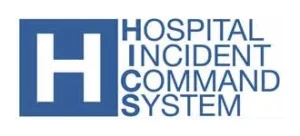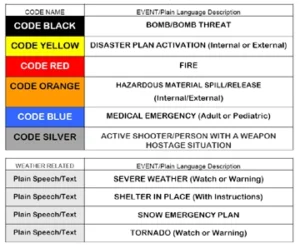Home Focus Areas Emergency Preparedness Resources
Emergency Preparedness Resources
Discover tools and resources, including the Emergency Response Guide, Active Shooter Guidelines, and more.
 The Hospital Incident Command System (HICS) is an incident management system that can be used by any hospital to manage threats, planned events, or emergency incidents. As a system, HICS is extremely useful; not only does it provide an organizational structure for incident management but it also guides the process for planning, building and adapting that structure. Using HICS for every incident or planned event helps hone and maintain skills needed for the large scale incidents.
The Hospital Incident Command System (HICS) is an incident management system that can be used by any hospital to manage threats, planned events, or emergency incidents. As a system, HICS is extremely useful; not only does it provide an organizational structure for incident management but it also guides the process for planning, building and adapting that structure. Using HICS for every incident or planned event helps hone and maintain skills needed for the large scale incidents.
The resources below will help your hospital prepare for emergency incidents using HICS.
 The Kentucky Hospital Association’s Board of Trustees has endorsed the recommendation of its Emergency Preparedness Committee, and approved adoption of a basic set of standard “overhead codes” for use in emergency situations.
The Kentucky Hospital Association’s Board of Trustees has endorsed the recommendation of its Emergency Preparedness Committee, and approved adoption of a basic set of standard “overhead codes” for use in emergency situations.
During emergencies and disasters, that the resources and talent of our health care system must be shared and potentially sent to other communities and regions of the commonwealth or nation. On a more local basis, some facilities are already sharing staff from PRN agencies and physician groups. As these people move from facility to facility, it appears logical that the codes which trigger emergency protective and response steps should be standardized to help ensure quick action.
These five codes represent fairly standard emergency situations that could threaten the facility, staff and patients. The four “weather-related” codes shown are recommended for communication to staff and visitors alike in plain speech or text to make sure there is understanding by all of the problem, and the appropriate actions to take. For example, when the National Weather Service issues a Tornado Warning, the overhead announcement would likely restate the warning, and instruct people to move to interior spaces away from windows and doors.
The intent of the KHA Emergency Preparedness Committee was to a set a base-level standard. They recognized that there may need to be facility, community or region-specific codes. As illustrations, a facility that offers pediatric services may want to consider s “Code Adam” for an infant or child abduction (following the national system adopted by Wal Mart); and a geriatric center may want to adopt a “Code Brown” for a missing adult patient (both of these examples are taken from standard codes adopted in Ohio).
NIMS Implementation Activities for Hospitals and Healthcare Systems
Download (PDF)
If a biocrime event is suspected, local emergency response systems should be activated. Notification should immediately include local infection control personnel and the health care facility administration, and prompt communication with the local and state health departments, FBI field office, local police, CDC, and medical emergency services.
This Microsoft Word document may be customized by hospitals with their own emergency contacts.
Download (MS Word)
This tool makes it possible to evaluate hospital disaster drills by using evaluation modules and addenda. The value of this approach is to identify specific weaknesses for improvement and to promote continuing efforts to strengthen hospital disaster preparedness.
Healthcare facilities, regardless of size, should develop an emergency water supply plan to prepare for a total or partial interruption of the normal water supply due to an emergency. This 2019 guide can provide a road map for health care facilities to prepare for, respond to, and recover from a total or partial water supply interruption.
Medical Textbooks – Emergency Medicine – Free Physician Reference Articles and Texts
The Emergency Response Guidebook (ERG2020) was developed for use by firefighters, police, and other emergency services personnel who may be the first to arrive at the scene of a transportation incident involving a hazardous material. It is primarily a guide to aid first responders in (1) quickly identifying the specific or generic classification of the material(s) involved in the incident, and (2) protecting themselves and the general public during this initial response phase of the incident.
The NIOSH Pocket Guide to Chemical Hazards (NPG) is intended as a source of general industrial hygiene information on several hundred chemicals/classes for workers, employers, and occupational health professionals. The NPG does not contain an analysis of all pertinent data, rather it presents key information and data in abbreviated or tabular form for chemicals or substance groupings (e.g. cyanides, fluorides, manganese compounds) that are found in the work environment. The information found in the NPG should help users recognize and control occupational chemical hazards.
The National Council on Aging (NCOA) urges that seniors equip themselves with the essential knowledge and actionable steps to navigate emergencies confidently.
Their “Emergency Preparedness for Older Adults Guide” includes:
- Considerations for those with hearing and visual impairments
- How to create an emergency plan
- Guidance on creating an emergency kit specific to older adults
- AHRQ
- Blast Injury Mobile Application (CDC)
- Biohazard Exposure (Ready.gov)
- Chemicals and Hazardous Materials Incidents (Ready.gov)
- Conditions of Participation
- Hospital Evacuation and Shelter in Place
- OSHA
- Best Practices for Hospital-Based First Receivers of Victims
- Pandemic Influenza Preparedness
and Response Guidance for
Healthcare Workers and Healthcare Employers
- Radiation Threat Info
- Trust for America’s Health
